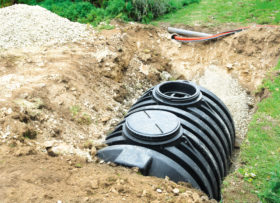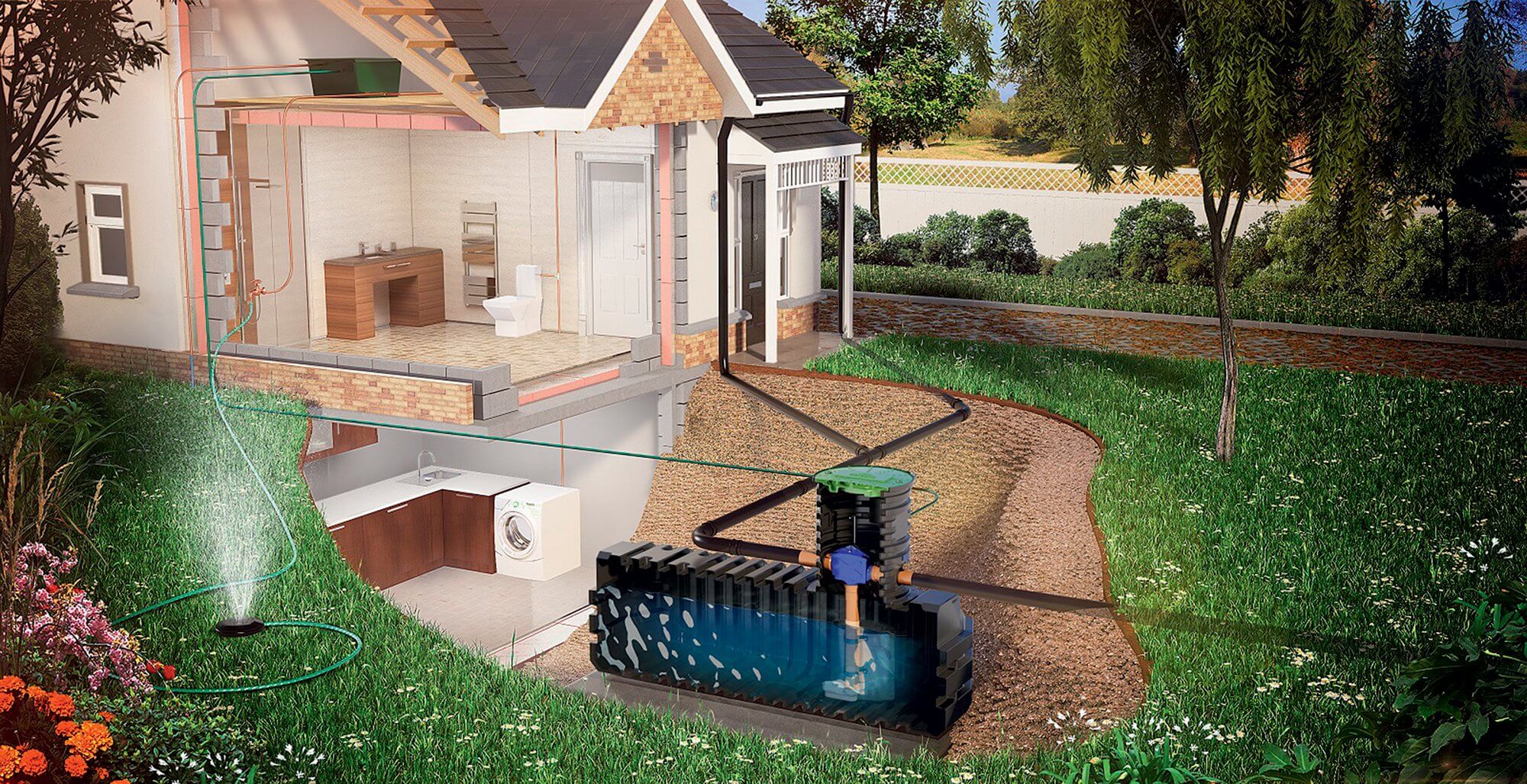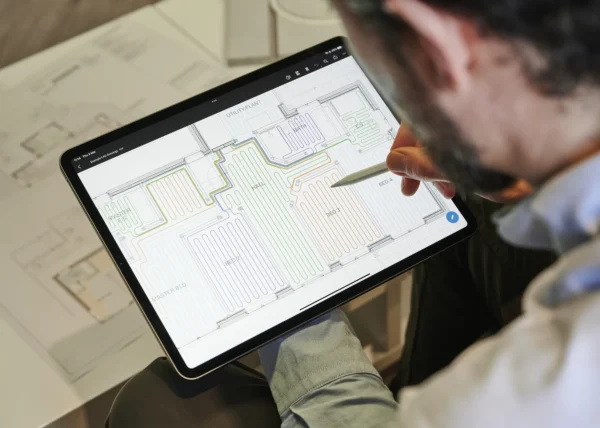Should I Install a Rainwater Harvesting System?
Put simply, rainwater harvesting is the collection and storage of rain for a variety of uses – but not for drinking.
The majority of systems are used to flush WCs, although it’s also possible to supply washing machines (the soft rain is ideal for laundry as it eliminates the need for conditioners), irrigate the garden and for other non-potable purposes.
Harvesting and reusing rainwater reduces your need for water from the mains. This minimises pressure on the conventional supply and, if your property is metered, can cut your bills. Rainwater harvesting also has a beneficial, if minor, effect on the drainage system as it holds run-off when it rains, rather than allowing it to go directly into the drains.
Owing to climate change, spells of heavy precipitation are expected to increase, so widespread harvesting and storage of rainfall could reduce the risk of local flooding. This might be a boon for some planning applications.
In most cases, the primary collection system is the roof. There are two reasons for this: firstly, there will already be a setup in place (the guttering and downpipes) that can be used to convey rainwater to a storage tank.
Secondly, although roofs are not perfectly clean, there are fewer contaminants than are present at ground level. Foreign bodies such as leaves, for example, can be easily removed.
Water is then pumped from the storage vessel, either directly to the points of use in the property or up into a secondary header tank in the loft for gravity-fed supply.
What are the storage options?
Rainwater tanks can be sited above or below ground, but the former will require protection from freezing. They’re somewhat unsightly, too, so will need to be disguised.
If it rained every day for an hour, tank sizes could be very small as you could use and refill them easily. However, even in the UK, it is not uncommon for two weeks or more to pass without rain, so a larger unit is normally required to ensure that you are still using harvested water rather than the mains after a prolonged dry spell.
Tank sizing is subject to the law of diminishing returns. The larger the vessel, the fewer the occasions when the mains backup will be required – but the effect decreases as the tank volume increases.
A size of 1,500 to 2,000 litres (1.5m3 to 2m3) will supply most of the WC and washing machine requirements of an average household. As a rule of thumb, 5% of the available annual rainfall is a good starting point for the tank’s storage capacity.
What is Greywater?Greywater recycling is often confused with rainwater harvesting – but the two are very different. Greywater is the reuse of water that has been used for showers, hand washing and washing machines. It can’t be simply used around the home like rain; it has to undergo a process of cleansing in order to be useful. So in domestic installations, greywater is channeled to a treatment unit where it is filtered and disinfected. Once it has undergone this process it can be sent to a storage unit and linked up to WCs around the home. In general terms, daily supply per person will roughly equate to demand. While it’s not as popular as rain collection, greywater can boost your home’s sustainability credentials, reducing your mains use and therefore minimising your home’s environmental impact. There are a number of specialists in the UK such as Aquaco , Aqulility and WTS. |
How much rainwater can I store?
To work out the amount of water that could be collected from a domestic property, the first step is to identify the size of the catchment zone.
This is basically the area of the roof in plan (and therefore similar to the size of the ground floor of the house). Next, find out the expected annual rainfall per m2 on your plot. Log on to the Met Office website to check average values for all areas of the country.
As an example, for a house in the West Midlands we would expect to receive an average rainfall of 669mm per annum. If the ground floor measured 5m x 10m (50m2), the available rainwater would be calculated as follows:
Average rainfall (m) x area of roof (m2)
= available water (m3)
In this case, the result would be 0.669m of rainfall x 50m2 ground floor area = 33.5m3 of available water. Only around 80% of this will actually be collected, as some rainfall will be lost to evaporation and overflow. So in our example, you might expect to harvest a total of 33.5m3 x 0.8 = 26.8m3 of usable water per annum.
For many homeowners, the roof shape will only allow straightforward harvesting on one side of the property, as costly pipework would be needed to convey water through or under the building.
A specialist supplier will be able to advise on your property’s potential – whether an existing roof or from the planning drawings for a new build.
Communal water harvesting systemsCommunal systems (usually sited underground) pool rainfall from several properties. These are slightly more efficient than individual systems. They benefit from the averaging effects of multiple uses; a 10m³ tank serving a group of 10 properties should require less mains backup in prolonged periods of low rainfall than a 1m³ tank serving a single home. As there are economies of scale in terms of installation, it should be possible to double the size and fit a single 20m³ tank for less than the cost of 10 separate 1m³ versions. So, a communal system offers a greater cost saving, an efficiency gain and, theoretically, overall further reduction in the demand for treated water. |
How does the mains backup work?
There are several ways to arrange a suitable mains backup, but the most common for direct-pumped systems is to fit a float switch inside the storage tank. This will sense when the level within the vessel reaches a critical low point, and then open the feed to refill with a limited amount of mains water.
As the tank only partially refills, there’s still capacity free for when it starts raining again. So the system will always favour the supply of harvested water.
The backup must be correctly installed, in accordance with the water regulations, to prevent contamination of the mains supply. There are legal standards regarding how pipes must be marked up, including the clear identification of rainwater pipework.
How much maintenance is needed?
Filtration is necessary to prevent leaves and other debris from entering the tank via the gutter system. But in theory, rainwater harvesting setups require little upkeep.
There are sophisticated self-cleaning options available, and some designs even reject the first flush of water when rain commences as this tends to contain the most debris.
When the tank is full, any excess siphons off to the surface water drainage system as normal. This overflow will also remove floating contaminants, which is a good reason to avoid oversizing the tank.
Is rainwater harvesting sustainable?
There is some debate about the overall environmental effectiveness of rainwater harvesting, as it takes energy to construct, install, run and maintain.
Embodied energy calculations are notoriously complex, but it turns out that the mains water system is actually a very energy-efficient way of delivering water to our homes and businesses.
Further research is evidently needed but, even though the payback period can be lengthy, instinctively it feels wasteful to purify mains water to drinking quality and then use it as a waste-disposal mechanism (ie for flushing WCs).
A further consideration is whether water efficiency has already been addressed in your home and the effective flush volume of toilets has been reduced to less than four litres.
In such cases, the demand for non-potable (non-drinking) water may be so low that there is little to be gained by installing such a setup.
How will climate change impact rainwater harvesting?As a result of climate change, spells of heavy rain are expected to increase in the future. Widespread harvesting and storage of rainwater could reduce the risk of local flooding. When it rains heavily, even an empty tank will fill within a relatively short space of time, but every litre of water that goes into your storage system will prevent a litre being discharged into the public drains (or your own soakaways) at peak periods of rainfall. Obviously, the larger (and emptier) your tank, the greater your contribution to this process of delaying rainwater discharge – so if you live in an area where your surface water drainage could contribute to a local flooding risk, a larger tank might be more appropriate. As you are usually excavating in any case, and the rest of the equipment does not change, then a larger tank should add only a little to the cost while increasing the usefulness of the system. |
What does a rainwater harvesting system cost?
It’s difficult to give an accurate answer to this question, as every property and household is different. If the tank is to be sited underground, the conditions and obstructions can vary significantly – and this could have a big impact on the final price.
However, a commonly quoted figure for a fully-installed 1,500 litre system is £2,500. The pumps are surprisingly efficient, so running costs are negligible (expect to pay well under £10 year in most cases).
Will I get payback?One of the big questions with any sustainable technology is how long it will take for the investment to be repaid through savings in running costs. Most water bills include a charge for the supply and the disposal of water. If your house is on a meter, the amount billed for both is calculated from the supply meter (this is known as a combined charge). If we assume a combined charge of £2 per m3, we can make some initial calculations to determine what level of savings you might be able to make by installing a modern rainwater harvesting system. Let’s look at two different scenarios: one for a 270m2 new-build (where installation is simpler and it’s relatively easy to use most if not all of the roof as a catchment); and the second for an existing house where only around half of the roof is available due to the difficulty of installing the required pipework (we’ve assumed 50m2). In both cases, we’ll use the average annual figure of 0.669m of rainfall cited earlier.
We can see from these examples that, as a rule, the more roof area available, the greater the potential mains water savings – and therefore the quicker the payback, even though the installation costs are higher. Note that these figures would change significantly if interest rates and water price escalation were unequal over the long term. If water prices were to rise more quickly, for instance, then the payback period for a rainwater harvesting system will be shorter. Bear in mind this calculation ignores any costs involved in maintaining the system (which should be minimal) and the small amount of energy required to run the pump. It also assumes that the household uses all of the harvested rainwater. It’s worth highlighting the fact that payback periods will vary across the UK. As an example, rainfall is greater in the south west of England, yet water charges are double those in the south east. This leads to the bizarre circumstance that you are likely to get your money back quicker for an installation in the south east, even though rainwater harvesting could theoretically do more good in the south west. |































































































 Login/register to save Article for later
Login/register to save Article for later
















